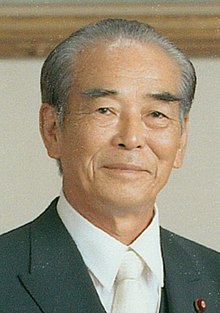Takami Eto
Takami Eto | |
|---|---|
 Takami Eto | |
| Director-General of the Management and Coordination Agency | |
| In office August 8, 1995 – November 13, 1995 | |
| Prime Minister | Tomiichi Murayama |
| Preceded by | Tsuruo Yamaguchi |
| Succeeded by | Masaaki Nakayama |
| Minister of Transport | |
| In office August 10, 1989 – February 28, 1990 | |
| Prime Minister | Toshiki Kaifu |
| Preceded by | Shinjirō Yamamura |
| Succeeded by | Akira Ōno |
| Minister of Construction | |
| In office December 28, 1985 – July 22, 1986 | |
| Prime Minister | Yasuhiro Nakasone |
| Preceded by | Yoshiaki Kibe |
| Succeeded by | Kōsei Amano |
| Personal details | |
| Born | April 10, 1925 Hyūga, Miyazaki, Japan |
| Died | November 22, 2007 (aged 82) Ho Chi Minh City, Vietnam |
| Political party | Liberal Democratic Party (Japan) |
Takami Eto (江藤 隆美, Etō Takami, 10 April 1925 – 22 November 2007) was a Japanese politician and former member of Japan's House of Representatives.
Career[edit]
Born in Hyūga, Miyazaki, Takami Eto studied at the Tomitaka business school (now Kadokawa High School), and graduated the Miyazaki Agriculture and Forestry College (now University of Miyazaki). After graduation, he ran for the Miyazaki prefecture assembly, and was elected three terms.
A conservative politician, Takami Etō joined in 1973 the political club Seirankai (青嵐会 - 'Mountain wind') founded by Shintaro Ishihara, one of Japan's most prominent "far right" politicians.[1] He was called "Japan's Le Pen" on a program broadcast on Australia's ABC.[2]
Eto was once considered a major power broker in Japan's Liberal Democratic Party.[3]
Eto served as the Japanese construction minister during the early 1990s, but resigned from the Management and Coordination Agency in 1995 following controversial comments regarding Japan's treatment of occupied countries during World War II.[3]
Etō retired from politics in 2003.[3]
Takami Etō was found dead in his hotel in Ho Chi Minh City, Vietnam, on November 22, 2007.[3] He was 82 years old when he died and had been in Vietnam on a private agriculturally related visit.[3] Japan's Kyodo News reported that Etō had died of an apparent heart attack.[3]
Historical revisionism, negationism[edit]
Etō was known for his revisionist views, and his negation of the existence of Japanese war crimes. He resigned from his post as minister in 1995 following comments in which he stated that Japan "did some good things" when it governed Korea, including building railroads, roads and schools.[3] Etō's comments threatened to cancel an important summit between South Korea's then President Kim Young-sam, whose government objected to Etō's comments, and then Japanese Prime Minister Tomiichi Murayama, a socialist who led Japan's coalition government, before Etō's resignation.[3]
Additionally, Etō defended the 1910 Japan-Korea Annexation Treaty which gave Japan control over Korea.[3] He stated in a speech, "Why was the country-to-country treaty called an invasion?...What's the difference between that and a merger of a town and a village?"[3] Etō also actively lobbied against school textbooks which mentioned so-called "comfort women" Comfort women were women from across Asia, including Koreans, whom Japanese troops forced into sexual slavery during World War II.[3]
Etō also denied the existence of the Nanjing massacre, which he considered as a hoax.[4]
Transmission of power and views to his son[edit]
Takami Etō's son, Taku Etō, took his father's seat in the House of Representatives of Japan.[3] Taku Eto is affiliated to the openly revisionist lobby Nippon Kaigi, which advocates a restoration of monarchy in the archipelago and negates the existence of Japanese war crimes. He was among the 86 MPs invited to the meeting for the 'one million people rally to protect the Imperial tradition' in March 2006,[5] and among the people who signed 'THE FACTS', an ad published in The Washington Post on June 14, 2007, in order to protest against United States House of Representatives House Resolution 121, and to deny the existence of sexual slavery for the Imperial military ('Comfort women').[6]
References[edit]
- ^ "Shintaro Ishihara. (World Beaters). – Free Online Library". Thefreelibrary.com. December 1, 2002. Archived from the original on May 26, 2012. Retrieved September 28, 2012.
- ^ Hall, Eleanor (May 2, 2002). "The World Today Archive – Japan's Le Pen". Abc.net.au.
- ^ a b c d e f g h i j k l "Japanese ex-minister found dead in Vietnam hotel room" - AFP - Nov 22, 2007 - Accessed Dec 1, 2014
- ^ "南京虐殺30万人はうそ 江藤氏、講演で発言" - JPN 47 news - 2003/07/12
- ^ "皇室の伝統を守ろう!日本武道館・一万名大会" - Nippon Kaigi website - March 7, 2006
- ^ [File:The_Facts_about_the_Comfort_Women.jpg]
External links[edit]
- Takami Etō obituary Archived 2007-12-17 at the Wayback Machine (in Japanese)
